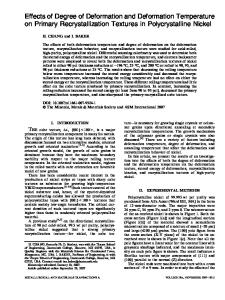Experimental deformation textures of OFE copper and 70:30 brass from wire drawing, compression, and torsion
- PDF / 762,703 Bytes
- 7 Pages / 590.28 x 785 pts Page_size
- 48 Downloads / 319 Views
I.
INTRODUCTION
T H E R E has been a strong interest in recent years in the prediction of deformation textures. Many important changes have been made from the original Taylor and Bishop and Hill calculations. Recent formulations of these models have included the effects of grain shape, latent hardening, and strain rate sensitivity. The results of such calculations can be conveniently expressed in terms of inverse pole figures or orientation distribution functions (ODF's). This investigation was undertaken to provide experimental data for direct comparison to the predictions of the current polycrystal plasticity codes. The present literature experimental data are very complete for rolling textures with accurate experimental ODF's. The data are not nearly as complete for torsion, compression, and wiredrawing. Most of the literature data of torsion textures exist as pole figures that do not include a complete projection of the stereographic sphere and also contain ambiguities. Most of the predicted textures have been published as both standard pole figures and inverse pole figures. Thus experimental inverse pole figures of. for example, torsion textures would provide a new and more accurate verification of texture code predictions. The classic literature data for compression and wiredrawing textures is m a form which is suited for comparison to inverse pole figure measurements. Both wiredrawing and compression produce fiber textures, in some cases with multiple components, that make comparison to inverse pole figures very easy. We elected to perform wiredrawing, compression, and torsion experiments for comparison with predicted textures. These are the deformation modes that have not been as completely documented as rolling but ones where a comparison with theory is possible. Torsion is particularly imM.G. STOUT and J.A. O'ROURKE are Staff Members at the Los Alamos National Laboratory, Materials Science and Technology Division. Los Alamos. NM 87545. Manuscript submitted November 9. 1987.
METALLURGICAL TRANSACTIONS A
portant as a deformation mode. It is a means of examining material behavior at large strains without having to remachine samples or conduct interrupted experiments, for example, rolling followed by tension. Torsional deformation is also a critical test of the predictive capability of the polycrystal plasticity theories to accurately predict textures. This is because torsion has only one plane of mirror symmetry. Wiredrawing, compression, and rolling all have at least three mirror planes of symmetry. Compression of fcc materials also represents a critical test of theory. This is because in compression of fcc material grains curl, producing a situation between Sachs and Taylor. We chose to represent our experimentally measured textures as inverse pole figures. Some of the earliest measurements of deformation textures were done on drawn wires. Ill It was found that because wiredrawing is an axisymmetric process, the textures could be described by specifying a crystallographic direction parallel to the draw
Data Loading...










